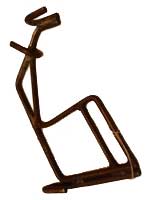Rope brake

Scenic cloths were attached to long bars, called flying bars, which were raised by a pulley system. When the bars holding the cloths had been raised into their correct position at stage level or in the flies, counterweights would be attached to hold them in place. As the bars were prone to shifting position, meaning that the scenic cloths were at risk of moving during performances, rope brakes would be applied to the ropes holding the flying bar to keep them stationary.  Rope brakes worked by bending the rope fed through them, thus creating enough friction to stop the rope moving. The brakes were also used to control scenery being lifted to and from the stage level. The rope brakes were designed and made by Technical Staff at the Royal Opera House, who stopped using them in 1997 as the computerised flying machinery has inbuilt brakes. This photograph at the left shows the rope brakes in action (centre at bottom).
Rope brakes worked by bending the rope fed through them, thus creating enough friction to stop the rope moving. The brakes were also used to control scenery being lifted to and from the stage level. The rope brakes were designed and made by Technical Staff at the Royal Opera House, who stopped using them in 1997 as the computerised flying machinery has inbuilt brakes. This photograph at the left shows the rope brakes in action (centre at bottom).
Image from the Richard Holttum Photographic Record of the Royal Opera House © Royal Ballet and Opera
Back